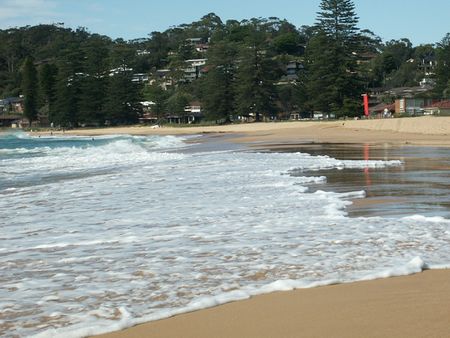Swash
Definition of Swash:
Up and down propagation of bores formed after collapse of waves on the beach. Swash is the decelerating uprush phase and backwash is the accelerating downrush phase.
This is the common definition for Swash, other definitions can be discussed in the article
|

Notes
Swash motion is a crucial link between the hydrosedimentary processes in the surf zone and the morphological dynamics of the beach. Swash motion can be quite strong. Maximum uprush velocities up to 3 m/s have been measured on steep sandy foreshores and up to 2 m/s on gently sloping foreshores, while backwash velocities can attain more than 2 m/s[1]. Uprush suspended sediment concentrations on steep and dissipative beaches can approach or exceed 100 g/l. The net sediment transport of a single swash event can cause fluctuations in beach level (accretion or erosion) by up to several centimeters. The net bed level change over an entire tidal cycle is often less than an order of magnitude larger than the change by individual swash events[2].
While easily observed and experienced by anyone walking along the beach, measuring the hydrodynamic characteristics of swash motion is not easy at all because of its small scale and highly unsteady nature. Swash motion is driven by waves collapsing on the beach which supply initial momentum to the wave uprush along with an amount of suspended sediment. This complex boundary condition, given the irregular character of the incident wave field, is not the only challenge for modelling the swash dynamics. The thin swash bore interacts with the beach sediment and the groundwater table by alternating water infiltration and exfiltration. The capability of process-based models to simulate these fine-scale processes is very limited. The contribution of swash motion to maximum water uprush (see wave run-up) and to beach accretion and erosion processes is therefore mainly based on empirical relationships. General trends can be fairly well described by these relationships, but field data are widely scattered around these trends. See the article Swash zone dynamics for a more detailed discussion.
On dissipative coasts swash processes are dominated by infragravity waves.
Related articles
References
- ↑ Houser, C. and Barrett, G. 2010. Divergent behavior of the swash zone in response to different foreshore slopes and nearshore states. Mar. Geol. 271: 106–118
- ↑ Puleo, J.A., Lanckriet, T. and Blenkinsopp, C. 2014. Bed level fluctuations in the inner surf and swash zone of a dissipative beach. Mar. Geol. 349: 99–112
